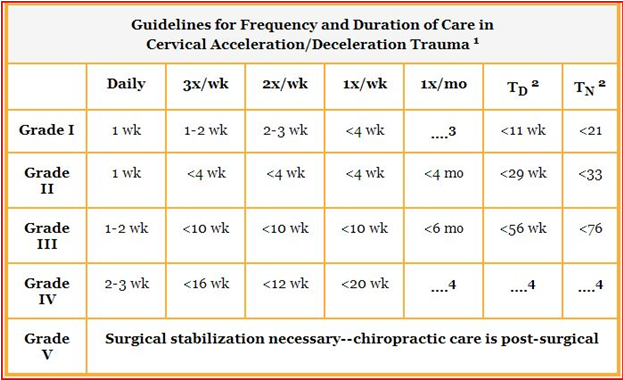The severity and long-term recovery of whiplash injuries vary considerably between individuals. No two cases are exactly alike. As you read in our previous post, Common Injuries from Whiplash, the severity of your injury depends on many factors, such as the speed and direction of the vehicles involved, your age and physical condition, as well as the position of your body at impact.
The severity of whiplash injuries fall into one of five categories, called ‘grades’ depending on the severity of your symptoms and the degree to which your soft tissues were damaged.
Grading whiplash injuries is something your chiropractor needs to do, but at least here, you’ll have a better understanding of what each grade means for you.
Grade 1 – Minimal injury
This is the mildest form of whiplash. In a Grade 1 injury, there is no limitation to your normal movement and no spraining of the ligaments that hold your joints together. There is usually only minor stretch damage to your muscles and your muscles usually are able to heal with little or no problem. Any pain is usually minor at first and may feel like the soreness from overexertion, or like you slept on your neck wrong. There may be some additional soreness, tenderness or minor swelling a few hours later or the next day. Usually, this is the form of whiplash suffered from a mild slip and fall, but is rarely seen with motor vehicle accidents. In auto collisions, the forces involved are just too great and the injuries are more severe.
Grade 1 injuries, on average, usually heal in less than a 10-12 week time frame with regular chiropractic treatments.
Grade 2 – Slight Injury
Grade 2 whiplash is the form of whiplash typically suffered in an automobile collision. Here, there is some limitation of motion due to muscular injury, spasm and swelling, but still no damage to the supporting ligaments in the cervical spine. The muscles are overstretched enough to cause some partial tearing and there is usually at least some degree of discomfort or pain that emerges immediately or very soon after the accident. Swelling can be quite severe over the following 24 hours, but usually recedes with rest and the application of an ice pack.
Grade 2 injuries usually require approximately 29-30 weeks of chiropractic treatment to completely recover.
Grade 3 – Moderate Injury
Grade 3 whiplash injury is where you begin to have damage to the supporting ligaments in the spine.  There is significant restriction in your range of motion due to muscle spasm and damage and radiating
There is significant restriction in your range of motion due to muscle spasm and damage and radiating
pain into the arms and legs may be present, indicating some possible nerve injury as well. There is usually a severe stretch and actual tearing and separation of the muscle tissue, and there may be some internal bleeding within the muscle tissue itself.
It is at Grade 3 that significant scarring and fibrotic changes begin to he seen in the injured muscles. Symptoms are usually experienced immediately or very soon after the accident, once the adrenaline from the accident has worn off. Pain may or may not be severe. There is usually considerable swelling in the area, and the swollen areas may be discolored from muscle bleeding. In deeper tissues, this might not be visible. Because of the damage to the ligaments, your spine may lose some of its stability, resulting in a predisposition for re-injury in the future.
Grade 3 injuries can require between 50-56 weeks of chiropractic treatment with additional treatment from massage therapy and therapeutic exercise program to completely recover.
Grade 4 – Moderate to Severe Injury
With a Grade 4 whiplash injury, the whiplash forces are significant enough to damage the spinal discs. All of the muscle and ligament damage described in Grade 3 are also present, but are more severe. In Grade 4 whiplash injuries, you begin to see a decrease in your normal reflexes, muscle weakness or loss of normal sensation.
All of the muscle and ligament damage described in Grade 3 are also present, but are more severe. In Grade 4 whiplash injuries, you begin to see a decrease in your normal reflexes, muscle weakness or loss of normal sensation.
Grade 4 whiplash injuries may require permanent monthly treatment after the initial 56 weeks of chiropractic care has been received.
Grade 5 – Severe Injury
This is the most severe form of whiplash injury. At this level, injuries may include fractured or dislocated vertebrae; complete tearing of muscles away from the bone, severe concussions, nerve damage and significant internal bleeding.
Grade 5 whiplash injuries usually require surgical management or stabilization.
Stages of Recovery
The different tissues that are damaged during a whiplash trauma heal at different rates and to different degrees. For example, muscle injuries tend to heal very quickly, where nerve injuries tend to heal very slowly. Ligaments and discs are very slow to repair and don’t heal as completely as muscles or nerves.
Although each tissue of the body heals at a different rate, they all tend to follow a predictable four-stage pattern.
Stage 1 – The Inflammatory Phase
Stage 1 begins at the time of the injury and continues for up to three days.
During this phase, inflammation occurs in the damaged tissues in an attempt to eliminate toxins and kill any invading bacteria so that the repair process can begin. Scar tissue begins to form as early as this first stage. Rest, ice packs and gentle movement is usually the best course of action during this phase. The treatment goals during this phase are simply to reduce pain, inflammation and muscle spasm.
Stage 2 – The Repair Phase
Once the initial inflammatory phase passes, damaged tissues begin the process of repairing themselves. This takes up to about 14 weeks. During this stage, your muscles and connective tissues are still very fragile. Scar tissue continues to develop and there is new growth of connective tissue and capillaries. Due to the high risk of re-injury, it is important to restrict your daily activities. The treatment goals during this phase are to control pain, help restore normal movement and function, and encourage the body to heal correctly.
Stage 3 – The Remodeling Phase
Stage 3 lasts up to the end of the first year after the accident. During this phase. the damaged tissues of the body are continuing to heal. Fibrous scar tissue is reconstituted into something more like normal connective and muscle tissue.
the body are continuing to heal. Fibrous scar tissue is reconstituted into something more like normal connective and muscle tissue.
Levels of activity continue to increase to help stimulate normal healing and restoration of function to the muscles, ligaments and connective tissues. By the end of this stage, any muscles or other tissues that have not fully healed or have not healed correctly will likely become permanent, chronic disabilities. The treatment goals during this stage are to restore normal patterns of movement and to increase muscle strength and endurance.
Stage 4 – The Chronic Phase
By this phase in recovery, any remaining tissue damage or loss of function will likely become permanent. The primary goal of treatment is to restore a normal lifestyle and prevent future injury.
REVIEW
The Four Stages
of Whiplash Recovery
Stage 1 – Up to 72 hours – Inflammatory Phase.
This is the phase immediately following the injury where the injured tissues are swollen and inflamed. During this phase. the primary goat of treatment is to reduce pain and inflammation.
Stage 2 – 72 hours to 14 weeks – Repair Phase.
Damaged tissues begin to repair themselves and there is development of some scarring. The primary goal of treatment is to reduce stress on the injured soft tissues and begin work to restore normal movement. The soft tissues are still easily re-injured.
Stage 3 – 14 weeks to 12 months – Remodeling Phase.
During this phase, the damaged tissues of the body are continuing to fully heal. The primary goals of treatment are to restore normal movement, strength and endurance.
Stage 4 – Over 12 Months – Chronic, or Permanent Phase.
By this phase in recovery, any remaining tissue damage or loss of function will likely become permanent. The primary goal is to restore a normal lifestyle and prevent future injury.


